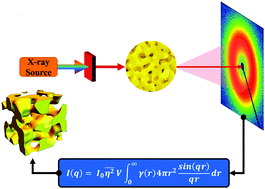当前位置:
X-MOL 学术
›
Nanoscale Horiz.
›
论文详情
Our official English website, www.x-mol.net, welcomes your
feedback! (Note: you will need to create a separate account there.)
Small-angle X-ray scattering of nanoporous materials
Nanoscale Horizons ( IF 8.0 ) Pub Date : 2019-08-16 , DOI: 10.1039/c9nh00347a Samuel S. Welborn 1, 2, 3, 4, 5 , Eric Detsi 1, 2, 3, 4, 5
Nanoscale Horizons ( IF 8.0 ) Pub Date : 2019-08-16 , DOI: 10.1039/c9nh00347a Samuel S. Welborn 1, 2, 3, 4, 5 , Eric Detsi 1, 2, 3, 4, 5
Affiliation

|
Small-angle X-ray Scattering (SAXS) is a non-invasive reciprocal space characterization technique that provides statistically representative microstructural information about a material. This focus article examines SAXS as a tool to probe the microstructure of nanoporous materials. We seek to educate the reader on scattering instrumentation and requisite scattering theory pertinent to nanoporous materials, and describe analytical models used to fit SAXS data, to elucidate the microstructure of these nanoporous materials including their morphological features such as the pore size distribution, pore curvature, and specific surface area. Finally, we fit and compare the aforementioned models to real scattering data of nanoporous gold synthesized in our laboratory. The models yield realistic material parameters for the nanoporous gold morphology, in agreement with electron micrograph images. In addition, we have investigated the scattering patterns and characteristic electron micrographs of nanoporous copper and nanoporous antimony also synthesized in our laboratory. The models discussed in this paper do not yield realistic material parameters for specific nanoporous copper and nanoporous antimony morphologies, however. This could be the subject of follow-up work.
中文翻译:

纳米多孔材料的小角X射线散射
小角X射线散射(SAXS)是一种非侵入性的相互空间表征技术,可提供有关材料的统计上具有代表性的微结构信息。本重点文章探讨了SAXS作为探测纳米多孔材料微观结构的工具。我们寻求教育读者有关纳米多孔材料的散射仪器和必要的散射理论,并描述用于拟合SAXS数据的分析模型,以阐明这些纳米多孔材料的微观结构,包括其形态特征,例如孔径分布,孔径曲率,和比表面积。最后,我们将上述模型与我们实验室合成的纳米多孔金的真实散射数据进行拟合和比较。这些模型为纳米多孔金的形态提供了逼真的材料参数,与电子显微图像一致。此外,我们还研究了也在我们实验室中合成的纳米多孔铜和纳米多孔锑的散射图和特征电子显微照片。但是,本文中讨论的模型并未针对特定的纳米多孔铜和纳米多孔锑形态产生实际的材料参数。这可能是后续工作的主题。
更新日期:2019-12-17
中文翻译:

纳米多孔材料的小角X射线散射
小角X射线散射(SAXS)是一种非侵入性的相互空间表征技术,可提供有关材料的统计上具有代表性的微结构信息。本重点文章探讨了SAXS作为探测纳米多孔材料微观结构的工具。我们寻求教育读者有关纳米多孔材料的散射仪器和必要的散射理论,并描述用于拟合SAXS数据的分析模型,以阐明这些纳米多孔材料的微观结构,包括其形态特征,例如孔径分布,孔径曲率,和比表面积。最后,我们将上述模型与我们实验室合成的纳米多孔金的真实散射数据进行拟合和比较。这些模型为纳米多孔金的形态提供了逼真的材料参数,与电子显微图像一致。此外,我们还研究了也在我们实验室中合成的纳米多孔铜和纳米多孔锑的散射图和特征电子显微照片。但是,本文中讨论的模型并未针对特定的纳米多孔铜和纳米多孔锑形态产生实际的材料参数。这可能是后续工作的主题。









































 京公网安备 11010802027423号
京公网安备 11010802027423号